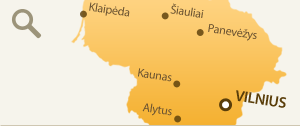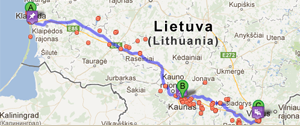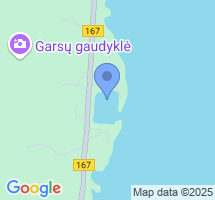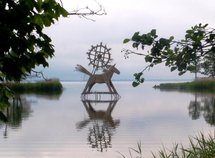Amber Gulf (Juodkrante)
In 1855, while canalizing the waterway near Juodkrantė, the workers discovered amber in the silt soil. Shortly after that, various businessmen expressed their interest in this discovery. The first person to start the works of organized excavation of mud from the bottom of the Lagoon for amber search was former miller, owner of ships, later Klaipėda innkeeper Vilhelmas Stantynas. When merchants from Dancig joined him, a company of amber excavation from the Lagoon’s bottom was founded. The Government also contributed to the company’s activity, since it canalized the ships navigation channel between Klaipeda and the Coast and wanted to have a benefit from amber search works for itself as well. Having united the efforts, the company began to flourish.
The company encouraged the residents of Juodkrantė to get involved into amber excavation, too. It was in need of cheap labor force. Having the volumes increased, spacious bunkhouses were constructed to the north of Juodkrante, ship repair workshop was opened, port quay and workshops for production of the divers’ clothes were equiped. Gradually, Juodkrantė became an industrial town.
The works of amber excavation were performed only in the summertime – around 30 weeks per year by three shifts. The amber excavated from the Lagoon’s bottom had to be cleaned and separated from admixtures. From 1860 till 1890, approximately 75 thousand kilograms of amber on the average per year were excavated. Having the amber mining declined, in 1890, the excavation works contract was not renewed, therefore, the excavation works in Juodkrante were terminated.
While digging the gulf’s port, a collection of amber ware of the middle neolithic and yellow metal ages was discovered on the Lagoon’s bottom. The amber collection was later entitled as the Amber Treasure.
The Treasure in the name of Ričardas Klebsas
Ričardas Klebsas deserved the most for preserving the collection, therefore, quite often the treasure is named after him. Having organized exhibitions in various cities of the world, this treasure became known and famous in the whole world. After the World War II, only 5 findings were left of Juodkrante’s treasure: three human figures, a hanger of phallus shape, and double ornamented disc. Along with other remained exhibits of the treasure, they are kept in Museum of Geology and Palaeontology of Goetingen University. According to descriptions and drawings from the book of R. Klebsas, the artist Bronė Kunkulienė made two sets of amber moulages, which currently are exhibited in Palanga Amber Museum and in Mizgiriai Amber Gallery in Nida.
More information: www.visitneringa.com
Nearby objects
 Nuomojame nuo balandžio15d. iki spalio 15d, kaina asmeniui 30-40 Lt. (~23 km)
Nuomojame nuo balandžio15d. iki spalio 15d, kaina asmeniui 30-40 Lt. (~23 km) Horsemarket jojimo paslaugų centras – puiki vieta mėgstantiems žirgus, gamtą ir geras emocijas. (~29.9 km)
Horsemarket jojimo paslaugų centras – puiki vieta mėgstantiems žirgus, gamtą ir geras emocijas. (~29.9 km) Vieno kambario apartamentų nuoma Palangoje vos už 50 Lt. parai (~40.9 km)
Vieno kambario apartamentų nuoma Palangoje vos už 50 Lt. parai (~40.9 km) Viešbutis, restoranas, mini SPA, vyno rūsys, konferencijų salė. (~130.6 km)
Viešbutis, restoranas, mini SPA, vyno rūsys, konferencijų salė. (~130.6 km) Šiaurės Lietuvoje, 28 km nuo Šiaulių, 5 km nuo Radviliškio, 49 km nuo Panevėžio, pakeliui į Tytuvėnus ir Raseinius, miškų apsuptyje, kur… (~154.2 km)
Šiaurės Lietuvoje, 28 km nuo Šiaulių, 5 km nuo Radviliškio, 49 km nuo Panevėžio, pakeliui į Tytuvėnus ir Raseinius, miškų apsuptyje, kur… (~154.2 km) Niekada negali žinoti ar tau patiks, kol pats neišbandai naujos pramogos. (~188.7 km)
Niekada negali žinoti ar tau patiks, kol pats neišbandai naujos pramogos. (~188.7 km) Viešbutis „Metropolis“, garsėjantis įspūdinga istorija, yra vienas iš labiausiai žinomų viešbučių Lietuvoje (~191.3 km)
Viešbutis „Metropolis“, garsėjantis įspūdinga istorija, yra vienas iš labiausiai žinomų viešbučių Lietuvoje (~191.3 km) Viešbutis – Restoranas „Sfinksas“ įsikūręs ramiame, netoli miesto centro esančiame kampelyje. Ramybė, aukštas aptarnavimo lygis, jaukumas –… (~192.3 km)
Viešbutis – Restoranas „Sfinksas“ įsikūręs ramiame, netoli miesto centro esančiame kampelyje. Ramybė, aukštas aptarnavimo lygis, jaukumas –… (~192.3 km) Conviva -nedidelis, jaukus 3 žvaigždučių viešbutis pačiame Panevėžio miesto centre. (~204.2 km)
Conviva -nedidelis, jaukus 3 žvaigždučių viešbutis pačiame Panevėžio miesto centre. (~204.2 km) Nauji, jaukūs butai Druskininkų senamiesty, prie Vijūnėlės ežero. (~249.8 km)
Nauji, jaukūs butai Druskininkų senamiesty, prie Vijūnėlės ežero. (~249.8 km) Druskininkų „Medinukas“ - ko gero pati jaukiausia vieta praleisti atostogas ar savaitgalį populiariausiame kurorte Lietuvoje. (~249.9 km)
Druskininkų „Medinukas“ - ko gero pati jaukiausia vieta praleisti atostogas ar savaitgalį populiariausiame kurorte Lietuvoje. (~249.9 km) Apartamentų Ratnyčėlė Druskininkuose nuoma. (~251 km)
Apartamentų Ratnyčėlė Druskininkuose nuoma. (~251 km) Kaimo turizmo sodyba „Gervių takas“ įsikūrusi 45 kilometrai nuo Vilniaus centro vaizdingose Trakų rajono Strėvos apylinkėse esančiame… (~255.3 km)
Kaimo turizmo sodyba „Gervių takas“ įsikūrusi 45 kilometrai nuo Vilniaus centro vaizdingose Trakų rajono Strėvos apylinkėse esančiame… (~255.3 km) Visai prie pat Šiaulių miesto 4 žvaigždučių motelis ir puikiai įrengta užeiga.
Jums siūlome 1 liukso, 4 pusiau liukso, 9 dviviečius… (~272.1 km)
Visai prie pat Šiaulių miesto 4 žvaigždučių motelis ir puikiai įrengta užeiga.
Jums siūlome 1 liukso, 4 pusiau liukso, 9 dviviečius… (~272.1 km) Poilsis, stovyklos, vaikų stovyklos, poilsio bazė „Rūta“, kaimo turizmas, apgyvendinimas, furšetai (~277.4 km)
Poilsis, stovyklos, vaikų stovyklos, poilsio bazė „Rūta“, kaimo turizmas, apgyvendinimas, furšetai (~277.4 km)
Vilniaus pedagoginis universitetas (bendrabutis – svečių namai)
VPU bendrabutis – svečių namai įsikūrę visai šalia Vilniaus senamiesčio, vos keletas minučių… (~280.5 km) Kavinė
Pas mus kvepia kava. Kviečiame stabtelėt, atsipūsti minutėlei ir pasimėgauti kvapnios puikios kavos puodeliu, tokios kaip Jūs… (~282.1 km)
Kavinė
Pas mus kvepia kava. Kviečiame stabtelėt, atsipūsti minutėlei ir pasimėgauti kvapnios puikios kavos puodeliu, tokios kaip Jūs… (~282.1 km) Drūtūnai – aktyvus poilsis gamtoje. Ignalinos rajone, nuostabios gamtos, ežerų bei upių apsuptyje įsikūrusi didelė, puikiai išpuoselėta… (~312.2 km)
Drūtūnai – aktyvus poilsis gamtoje. Ignalinos rajone, nuostabios gamtos, ežerų bei upių apsuptyje įsikūrusi didelė, puikiai išpuoselėta… (~312.2 km)
Nearby attractions
 In 1995, in Juodkrante, the construction works on 2400 m long quay along. Rėzos street were…(~1.2 km)
In 1995, in Juodkrante, the construction works on 2400 m long quay along. Rėzos street were…(~1.2 km)
Wooden Sculptures Exposition At The Hill Of Witches (Juodkrantė)
One of the most beautiful and oldest parabolic dunes in Juodkrante is the Hill of Witches. The…(~2 km) Žirgų horn lighthouse wasbuilt in 1900 in the Curonian Lagoon at Pervalka behind the Agila bay, in front of the Žirgų horn of cape…(~14.8 km)
Žirgų horn lighthouse wasbuilt in 1900 in the Curonian Lagoon at Pervalka behind the Agila bay, in front of the Žirgų horn of cape…(~14.8 km) Monument to Königsberg University theology professor, the famous first part nineteenth century man in culture, the Bible publisher,…(~15.4 km)
Monument to Königsberg University theology professor, the famous first part nineteenth century man in culture, the Bible publisher,…(~15.4 km) Kintai - resort village near Kursiai sea. Kintai is surrounded by beautiful pine-forest (600 ha) - Kintai forest.(~16.8 km)
Kintai - resort village near Kursiai sea. Kintai is surrounded by beautiful pine-forest (600 ha) - Kintai forest.(~16.8 km) A sculpture design - little boy with a dog waving with his hat, emerged on the terminal in summer 2007. (~17 km)
A sculpture design - little boy with a dog waving with his hat, emerged on the terminal in summer 2007. (~17 km) In Klaipėda Old town you will face the oldest buildings of the city, dating from the middle of the 18th century. (~17.1 km)
In Klaipėda Old town you will face the oldest buildings of the city, dating from the middle of the 18th century. (~17.1 km) You cant take a look at so called "crafts yard" located in the Old town of Klaipėda city.(~17.2 km)
You cant take a look at so called "crafts yard" located in the Old town of Klaipėda city.(~17.2 km) The main feature of the Theater Square is the sculpture called "Taravos Anikė" (Ann from Tharau).(~17.3 km)
The main feature of the Theater Square is the sculpture called "Taravos Anikė" (Ann from Tharau).(~17.3 km) Klaipėda Theatre square is the heart of the city. There is a sculpture of Ann from Tharau in the fountain in the middle of the square.(~17.3 km)
Klaipėda Theatre square is the heart of the city. There is a sculpture of Ann from Tharau in the fountain in the middle of the square.(~17.3 km) Klaipėda is the oldest Lithuania's city: first mentioned in the Chronicles of Memelburg in 1252.(~17.3 km)
Klaipėda is the oldest Lithuania's city: first mentioned in the Chronicles of Memelburg in 1252.(~17.3 km) Drama theatre started its activity in 1935 when closed Šiauliai theatre troupe moved to the seaport. (~17.3 km)
Drama theatre started its activity in 1935 when closed Šiauliai theatre troupe moved to the seaport. (~17.3 km) In front of Jazz club "Kurpiai", in Klaipėda Old Town, a sculpture of a little mouse was build…(~17.3 km)
In front of Jazz club "Kurpiai", in Klaipėda Old Town, a sculpture of a little mouse was build…(~17.3 km) A steel sculpture "Dragon" was created appealing to one of the legends retelling emergence of Klaipėda.(~17.3 km)
A steel sculpture "Dragon" was created appealing to one of the legends retelling emergence of Klaipėda.(~17.3 km) At the beginning of 2006, the entrance to Old Town was guarded by mans best friend - the dog. This sculpture of Doberman is named "The…(~17.3 km)
At the beginning of 2006, the entrance to Old Town was guarded by mans best friend - the dog. This sculpture of Doberman is named "The…(~17.3 km) Algirdas Bosas bronze sculpture "Tower" rose up in Old Town in 1990. In this place there once stood a house which burned down during…(~17.4 km)
Algirdas Bosas bronze sculpture "Tower" rose up in Old Town in 1990. In this place there once stood a house which burned down during…(~17.4 km) Klaudijus Pūdymas bronze sculpture decorated a crossroad of Tiltų and Turgaus streets.(~17.4 km)
Klaudijus Pūdymas bronze sculpture decorated a crossroad of Tiltų and Turgaus streets.(~17.4 km) "Old Town Cat" or you can call it "A cat with gentlemans face" started to live in Klaipėda Old Town from 1979. (~17.4 km)
"Old Town Cat" or you can call it "A cat with gentlemans face" started to live in Klaipėda Old Town from 1979. (~17.4 km) Klaipėda old town was decorated with one more decorative element - next to the building in Tiltų Street 1 you can find a basket with…(~17.5 km)
Klaipėda old town was decorated with one more decorative element - next to the building in Tiltų Street 1 you can find a basket with…(~17.5 km) Kursiu nerija (Curonian Spit) is a narrow and long (97 km) band of sand, which stretches along…(~17.5 km)
Kursiu nerija (Curonian Spit) is a narrow and long (97 km) band of sand, which stretches along…(~17.5 km)






